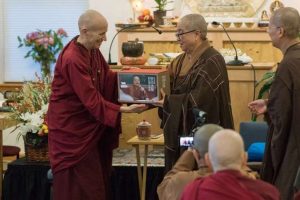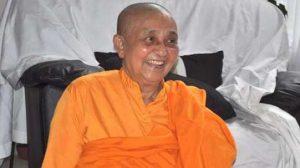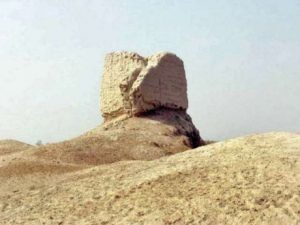We feature this interview with Venerable Nirodha from the Dhammasera Monastery in western Australia conducted by our Dhamma friend, Eng Chin Ho, of the Buddhist Fellowship organization in Singapore.
We share with you her personal story to offer perspective on some joys and challenges that face women today in their interest to become nuns in Buddhism.
A Nun’s Journey
Q1: Venerable Nirodha, please tell us about your background and what led you to take the Buddhist path?
I was born in Austria in 1945, and arrived in Australia age 20; I married and divorced, and had no children. I enjoyed lots of travel, a relatively good life, but there slowly arose an increased awareness of no end of wanting & getting.
On a health retreat sometime in the late 1970s, feeling bored, trying to decide whether to play tennis or a card game of Bridge, a sudden deep moment of stillness arose, a sense of giving up the endless choices and mental activity. From within that depth a clear question arose in my mind: Do I want to continue with this shallow, easy way of life, or do I want to look for the Truth? Without hesitation there came the strong desperate answer and determination that I must look for the Truth; even more, I wanted to become the Truth.
After snapping out of this experience, life went on, but with a subtle shift in direction. I did not return to my childhood strong Christian roots, but remained open. One day in 1979, on a short visit to Sydney, my friend invited me to meet her Buddhist teacher, Anagarika Munindra-Ji, at an open house gathering. My other plans for the day got cancelled, so on a whim, I went. When I was introduced to the teacher, as a greeting, he said, “What are you doing?”. For the first time, I understood on a deeper level, and thought, yes, I am doing nothing with my life. I answered, “I am doing nothing”.
An hour or two later, when it was announced that in a few days this Teacher would give a 9-day meditation retreat in a forest monastery outside of Sydney, I knew I had to go. The retreat would be at Wat Buddha Dhamma, co-led with Venerable Ayya Khema and Ven. Khantipalo. When I told my friend, she was aghast. She cried out, “You know nothing about Buddhism! You can hardly even spell the word ‘Buddha’!” She had studied extensively before starting her path.
Yet I went to the retreat, where I followed instructions and felt at home with the Buddha’s teachings. My quest for the Truth had brought me to the Dhamma. From then on, I gratefully and happily participated in Buddhist activities as much as possible, first in Australia, then Sri Lanka, USA, Burma and Thailand, and now back in Australia.
Q2: Venerable, please describe your feelings and thoughts when you received ordination as a nun?
For me, ordination was not just one experience, but three. First was the Anagarika ceremony in 2001: undertaking 8 precepts, shaving the head and putting on white robes. There, my ordinary householder life ended. Next was the 10-precept nun ordination in 2003: gaining brown robes, and relinquishing all money and assets, to the shock of my friends and family. Since considerable assets were involved, even the bank rang up to make sure I was of sound mind. My loved ones had slowly adjusted to my new direction in life, yet were still stunned that I carried out the final step, leaving everything behind; as this implied that the world had nothing to offer, ever, it made a big impact upon them. Both of these ordinations were profound experiences for me. But the deepest one occurred in 2009 at my higher ceremony as a bhikkhuni.
The male and female Maha-Sangha turned out in full force, even more than the needed number. Their full support was evident. From my heart I said these words: To end all suffering, to realize Nibbana, please raise me up out of compassion. That is, may they raise me into Sangha status. And they did, in Pali, reciting the same phrases that the Buddha used.
An indescribable unique experience happened during my ordination, of linking up, as though being received into the pure Sangha realm, with all the Sangha blessings. From that day on, I gratefully enjoy the complete lifestyle that the Buddha compassionately gave his ordained disciples, which is the greatest support for the mind’s development.
Q3: What does it mean to renounce? You mentioned in your talks that there are two levels of renunciation – external and internal. Please elaborate.
External renunciation is quite easy, once you start to see the burden of owning anything, and see that you don’t own it in the first place. “Owning” means in control; permanence. But are you really? Please contemplate this. If you see the truth you may end up saying “thank you” to those who take away from you these burdensome possessions.
Personally, I was also struck by the question, “What good is it to sit on a pile of gold, and no one to give it to?” As someone used to say, “I prefer to give with a warm hand rather than with a cold one…!”
Because of our so-ingrained sense of self, we are constantly seeking and being reconfirmed in the world on the appearance level, desperately trying to find a place of security in an inherently unstable, unsatisfactoriness, unstableness, and inability to claim ownership.
The algebra of life experiences brought to a simple equation: Samsara is movement; stillness is Nibbana.
Q4: Please give us an idea of what life is like in a monastery? What is your daily routine like?
Every monastery strikes some balance between group activities, work, and time for quiet reflection and meditation. The emphasis depends upon the priorities and circumstances of each monastery. The workload, for example, may be shared among a few residents or many, with or without helping hands from volunteers. The community’s highest priority may be meditation, or teaching the Dhamma, or offering ceremonies, or guiding those who are newly ordained; or building infrastructure may be the priority at times.
At Dhammasara we presently focus on developing the community, particularly guiding newly ordained members, while also teaching the Dhamma. Also a high priority is meditation time & retreat time for our community members; therefore we allow time for that. Right now we must also focus on developing infrastructure to give our quickly growing community a place to reside. Depending on donations received, the building phase may be long or short.
Thank you Venerable Nirodha for sharing your story!
Sadhu, Sadhu, Sadhu!
For additional information, please visit:
http://video.buddhistdoor.com/movie/play_movie_view_eng/1281in













